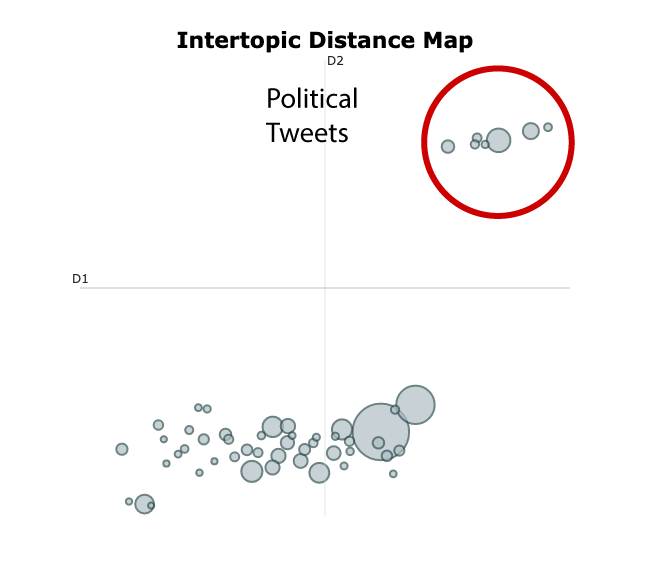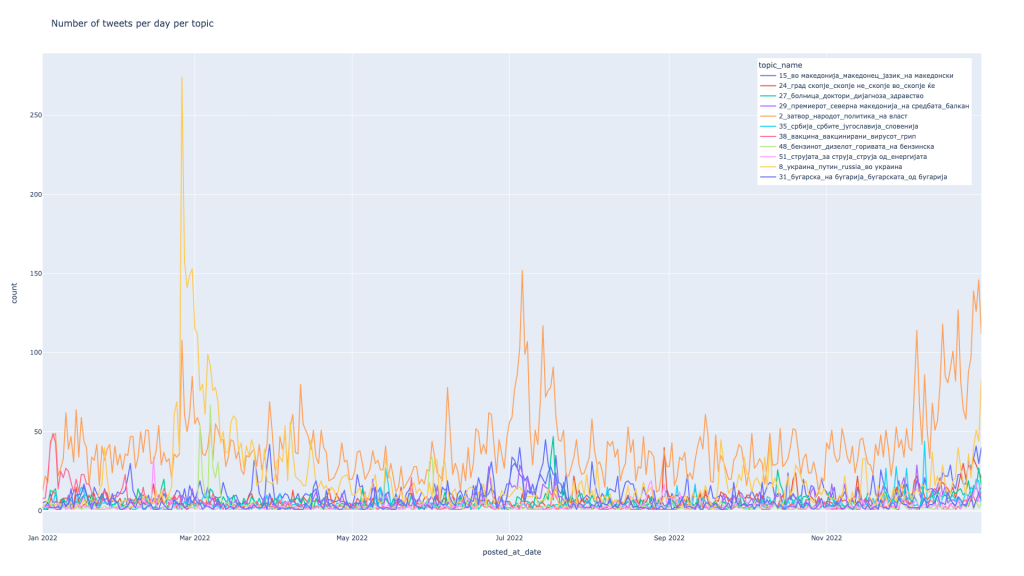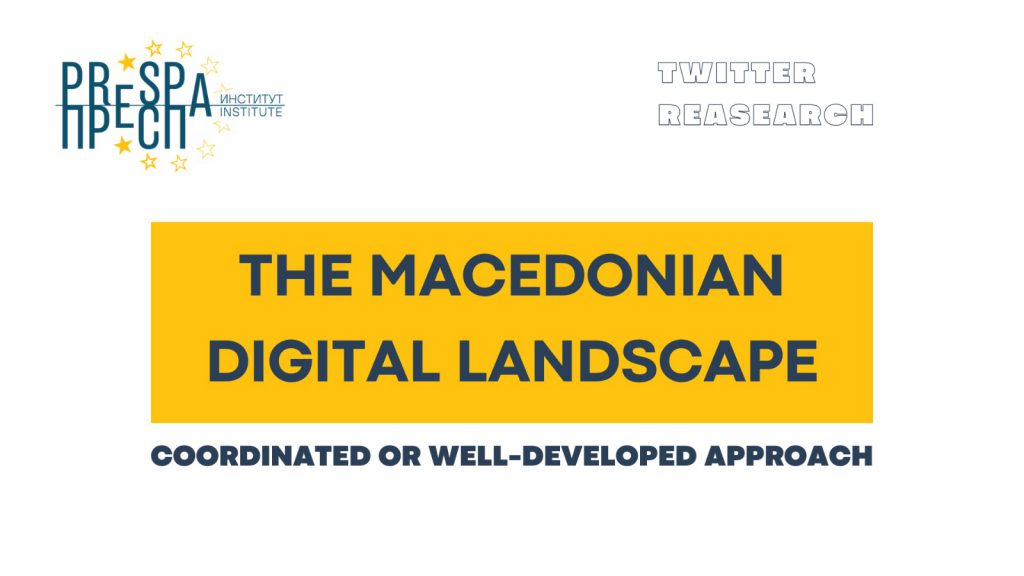Demijan Hadji-Angelkovski, Research Fellow
Andreja Stojkovski, Senior Researcher-Analyst
Introduction
This analysis is a part of the Impact and Image Observatory, where the statistical analysis of the posts and mentions of the countries of interest to the Observatory represents the indicator of the variable “Social Media”. This document speaks about the Macedonian Twitter Sphere and contains a quantitative and basic qualitative analysis of the public discourse in the Macedonian Digital Landscape. For the purposes of the analysis, the posts from the users with the largest reach, number of followers and T-index in the Macedonian Twitter sphere were analysed. That is almost 300 users. The analysis is made to their posts from throughout 2022. These users were chosen since they have the greatest reach and represent creators of the public discourse in the Macedonian Digital Landscape.
The analysis includes 519,354 tweets from 11,721 unique users. The number of users increases from the initial number since we also took their retweets, quotes and post replies. The tweets were first subjected to a basic cleaning of the text (removing links, emoticons, hashtags, etc.), and then through the use of machine learning and natural language processing, we looked for the hidden (latent) topic of each post.
Twitter is not… Politics only!
From the total number of 52 topics that we identified for 2022, 11 topics were of interest for our analysis. All posts from these 11 topics, or rather 40,399 posts, were subjected to in-depth analysis. These 11 topics or 40,399 tweets are actually political, activists’ tweets and represent almost 8% of the total volume of digital conversations on Twitter.

Briefly presented, the topics of interest are:
- Criticism of Macedonian politicians (15,063 posts);
- Ukraine, Russia, Putin (7,051 posts);
- Macedonian National feelings (4,312 posts);
- City of Skopje (2,447 posts);
- Health system (2,236 posts);
- Government, Prime Minister, Ministers in the Government of North Macedonia (2,180 posts);
- Bulgaria, Bulgarian, Bulgarians (1,901 posts);
- Serbia, Serbian, Serbs, Yugoslavia (1,601 posts);
- COVID-19, vaccines and vaccination (1,481 posts);
- Gasoline, diesel, expensive fuel (1,091 posts); and
- Energy crisis, the price of electricity (1,036 posts).
Tweeting Statistical noise
The basic analysis of each of the 11 topics of interest showed that the same five profiles appear in the top 10 users with most tweets on each individual topic. Moreover, these profiles are responsible for 15% of the total number of posts on all monitored topics, but on average they do not have more than 2-10 likes per post, that is, no more than 1 retweet. Compared to the total number of likes and retweets that happened in the Macedonian Twitter sphere, they contribute only 0.35%. In other words, in the statistics of published tweets, but also the interaction between different profiles, these users are tweeting statistical noise. However, what must be kept in mind is that the interactions between different users of a single post are not always important. Sometimes, the number of posts contributes to a more frequent appearance on the timeline and often as a recommendation by Twitter for profiles that one might want to follow or topics that might be of interest. Additionally, if one considers the fact that these five users contribute to such a large proportion of the total number of tweets, then it is more than clear that their goal or task is not to grow their personal influence or reach in the Twittersphere, but to promote “their” position and to open, impose or keep alive the topics that are in “their” interest.
This analysis only includes data that is available from the Twitter platform. It does not include the influence that different users and their individual posts have with the appearance of the information aggregator time.mk, as well as the new algorithm and the grouping of users from the Macedonian Tweeter sphere that the owner of the aggregator made. What should be taken into account is the fact that appearing in the “most popular” tweets in the last 2 i.e., the last 6 hours on the time.mk aggregator presents these posts to others, who are not users of the network, and thus contributes to the promotion of their views/tweets. The aggregator has millions of views and visits per month, and thus all the posts that appear on the frontpage, including the “most popular” tweets, get more views/reads without being recorded by Twitter.
Global affairs from the national viewpoint

If we look at the different topics and the activity by days throughout the year, we see 3 very clear peaks of activity, which correlate with the beginning of the Russian invasion on Ukraine, the protests against the so-called “French proposal” and the adoption of the Budget for 2023 and the growing calls of the international community to solve the problem of corruption in the country. On the other hand, vaccination and Covid-19 is an active topic only at the beginning of 2022, during January, which almost disappears with the beginning of the Russian invasion.
Macedonian Twitter users start posting about the Russian invasion on Ukraine, even before its beginning. The bulk of the tweets shared on this topic come from the above mentioned five profiles. It is noteworthy that they have expressed pro-Russian views, were active in the period before the invasion following the general narrative that drew a line of conflict between NATO and Russia, always justifying or glorifying the latter side, and continue with justifying the invasion as the liberation of the “Russian territories”. This theme continues throughout the year, often and for longer periods of time with a minimal number of tweets, returning again in the period of September and October, although not with such a strong intensity.
The difference between the posts before and after the start of the invasion is noticeable. In the weeks leading up to the invasion itself, the featured profiles spread a standard pro-Russian narrative. While, after the beginning of the invasion, they expand the topic with clear anti-Western, anti-NATO and anti-Ukrainian tweets. For the sake of truth, during the latter period there are also tweets condemning the invasion, expressing views against Russian President Putin, and supporting Ukraine in its defence. These posts are followed by a significant expansion of the group of profiles that have harsh pro-Russian rhetoric.
The de-escalation of the topic of the Russian invasion opens up space for new topics, in this case clearly related, aimed at domestic politics and policies. For example, during March, for the first time in 2022, the topic of the price of gasoline and diesel arises, while the publication of the results of the census in 2021 opened, or in this case, renewed and strengthened the topic of Macedonia and the Macedonians, which then simmered until the beginning of the protests against the so-called “French proposal”. During the protests, it was clear that the theme of Bulgaria was being strengthened i.e., tweeting against the opening of Bulgarian clubs in North Macedonia and the general anti-Bulgarian thread, which is intensively promoted by a very small group of users. Finally, during the entire year 2022, one topic is constant and with an almost constant intensity of posts, Serbia and the Serbian people, and a clear pro-Serbian, positive, narrative is visible.
Three common denominators
The entire analysis establishes three common points:
- The Individuals or profiles who are posting;
- The sequencing of the topics on which posts are placed;
- The intensity with which the posts are placed,
from which the conclusion can be drawn that there is a coordinated or well-developed approach towards the Macedonian Digital Landscape in which all topics are properly sequenced and adapted to attack and question the confidence in the functioning of institutions and the correctness of the policies that are being developed, particularly our NATO membership and the Accession to the European Union. In doing so, the coordination is reflected in the part of the participants and their tweets, quantitatively, but also qualitatively, while the planned or well-developed approach is reflected in the fact that all topics of interest are connected, one following the other and have a similar narrative. If we analyse the effect of the intensity with which the tweets are being shared, then, fortunately, they don’t lead to policy change. However, as already indicated above, the goal or task is to effectively lead the public discourse and change public opinion.

